

Apple harvest is in full swing; most Cox have been picked and Gala picking is well under way......
Today - Friday 25th September The English Apple Man joined industry colleagues at Hadlow College for the third - Pip to Plate event. The event is aimed at educating local secondary school students about the mechanism of top fruit production and the career possibilities open to them.
The first Pip to Plate took place on 27th September 2013 - See Pip to Plate 2013 for details.
This, the third Pip to Plate was once again blessed with perfect weather allowing the event to fully utilise the BIFGA training orchard generously provided by Nurseryman John Breach Chairman of BIFGA back in 2009. The process is designed to look at key elements of apple production from the Pip to the Plate........
Below: a plan of the Pip to Plate process, starting with 1. History & 2. Genetics....
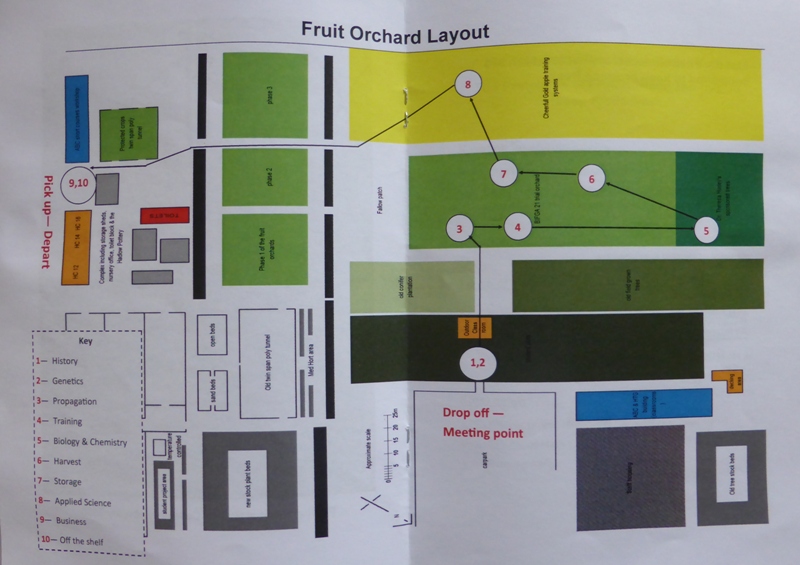
First up was 'yours truly' - The English Apple Man - covering the history of the origin of the sweet apple, followed by Sarah Calcutt who gave the students an overview of how 'genetics and breeding' is managed at East Malling Research. Sarah was born into a fruit farming family in Kent and is Chair of The National Fruit Show. She also runs 'Partners in Produce' a business that specialises in promoting English produce.
History
The origin of the sweet apple is believed to be the Tian Shan (Shan = Mountains) fruit forests that spread from Western China through Kazakhstan across central Asia millions of years ago. DNA evidence supports the conclusion that the sweet apple we know today evolved - assisted by the Brown Bears in the forests, rather than by hybridisation - 'natural or man made' - the discovery of grafting and budding in the Euphrates region 3,800 years ago allowed a favoured variety (then a single tree) to be replicated.
Genetics / Breeding
Sarah told the students 'genetics' does not mean GMO, but how our breeders develop new varieties by using he DNA profile of known varieties to cross those with good characteristics; e.g. eating quality, traits for resistance to pest and disease etc. and by taking pollen from one variety and brushing it onto the flowers of another variety; both under an enclosed environment (bags) the fruit from that union will produce apples and the seeds will be planted on to create new plants - those plants will be under a selection process for potential new varieties - some will fall by the wayside (not even germinating) but survivors with healthy attributes will be grown on and budded onto root-stocks before planting out in trial plots. Sarah told the students this process is very time consuming and the later stages of trailing and testing for commercial potential 'time consuming and very expensive....
It takes between 20 & 30 years before a seed (pip) is ready to become a new commercial variety and from thousands of seeds planted only two or three will even make the final trial stage.
Below: The English Apple Man and Sarah Calcutt addressing Students at the 2015 Pip to Plate
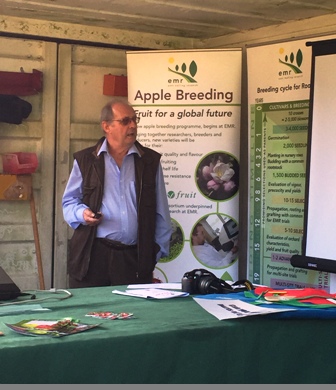
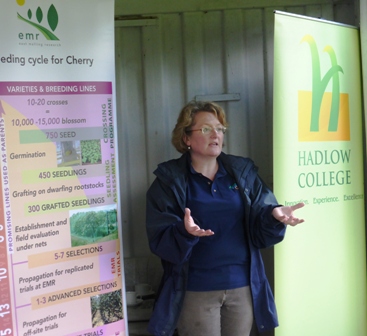
Propagation
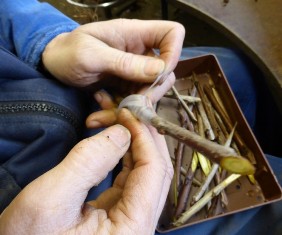 The next step in the process involved Propagation; this was the task of Terry Parris who has been part of Hadlow College for many years. Propagation can be described as "the creation of individuals from parent stock" - Naturally plants propagate from seeds. Apples are notoriously variable from seed and the characteristics of the parent plants (trees) are not consistently reproduced through propagation by seed. The most widely used method of vegetative propagation is by grafting and/or budding.
The next step in the process involved Propagation; this was the task of Terry Parris who has been part of Hadlow College for many years. Propagation can be described as "the creation of individuals from parent stock" - Naturally plants propagate from seeds. Apples are notoriously variable from seed and the characteristics of the parent plants (trees) are not consistently reproduced through propagation by seed. The most widely used method of vegetative propagation is by grafting and/or budding.
Bringing the 'scion wood' (variety) into a union with the 'rootstock' is either carried out by taking a bud from the scion and placing it carefully into a cleft in the rootstock. This can only be done in Summer (August) when the bud wood is at the right stage for union with the actively growing rootstock. Grafting can be carried out over a longer period. Normally in the spring time in an orchard as the sap is rising - the grafter will take a graft (short piece of scion wood) cut in the dormant winter period and kept in a cool place until the time for grafting onto the tree; this has been historically used to change a mature tree of a poor variety (commercially unnattractive) to a more desirable variety. In recent times (last few decades) the use of 'bench grafting' has become an integral part of the nurseryman's tool kit;
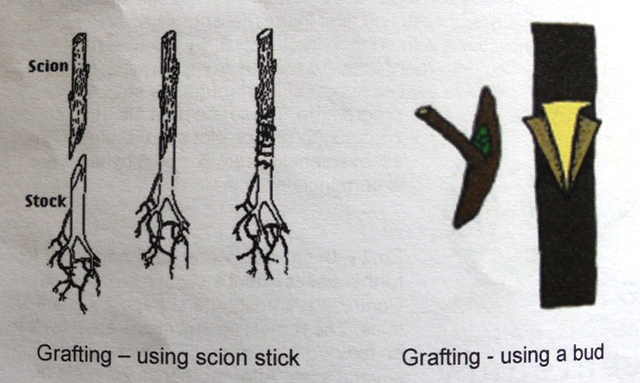
Below: Terry Parris addressing students - and - demonstration material simulating the grafting process
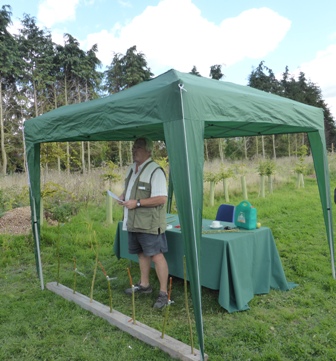
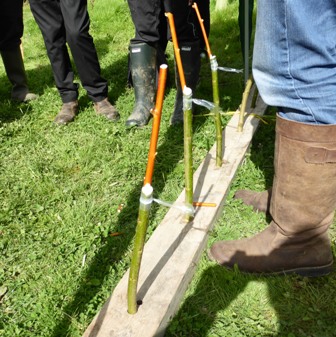
Tree Training
Brian Thompsett demonstrated "Training the frame on which to hang the apple" - explaining the tree is made up of two sections; the rootstock & the scion. The rootstock consisting of the roots and the first part of the trunk; 'its function to control the vigour or strength of the tree. The scion grafted or budded onto the rootstock, when it grows forms the upper part of the tree, this part is the cropping zone and dictates what variety is grown.
Brian told students, the fruit tree consists of Branches, Shoots, Leaves, Flowers and Fruits. The leaves are the engine room of the tree and through photosynthesis harness the energy of the sun and manufacture carbohydrates, the food available to the tree. When pruning it is important to be able to identify; 1 year, 2 year and 3 year branches and the difference between leaf bud and fruit bud.
Below: Brian Thompsett demonstrated how the tree is trained to create a structure on which to grow a crop
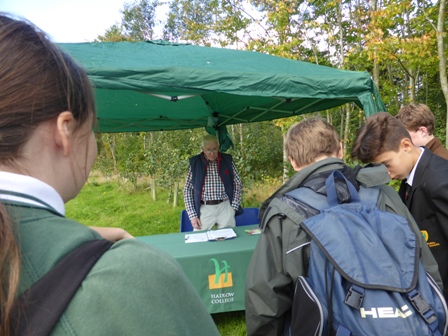
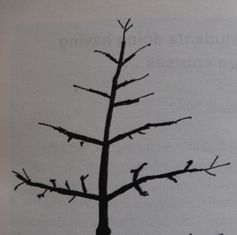
Biology & Chemistry
Below: Hutchinsons again supported the Pip to Plate event - and - Rob Saunders is seen here explaining the intricacies of pest and disease control
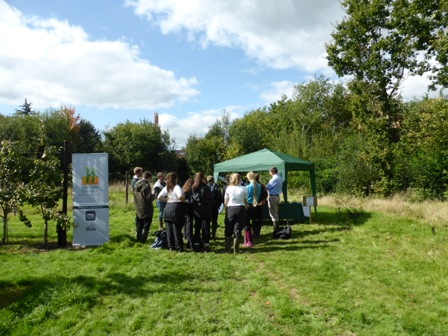
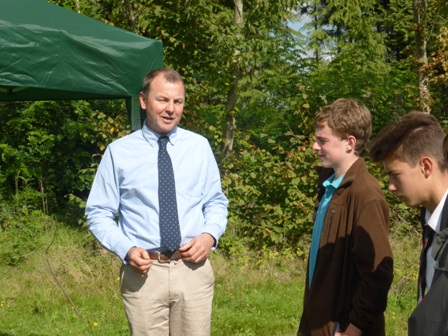
Understanding the insect life within an orchard is an important aspect of controlling pests; Rob Saunders demonstrated how by shaking the tree falling insects within the tree canopy can be caught and identified. The 'catch' may identify 'friend as well as foe' with predators an integral part of modern pest control enabling the reduction of pesticide controls.
Rob and Mike Hutchinson also explained how important it is to vary the pesticides used; Rob used the analogy of MRSA and how over use of Antibiotics lead to resistant bacteria in humans - the same applies to controlling pests - over use of 'one pesticide' will lead to pest resistance, and once a pair of 'resistant' pests pair up, it takes no time to build a resistant population...........
Below: Mike Hutchinson and Rob Saunders (with trap) explain how to shake a tree and catch the falling insects within the tree canopy
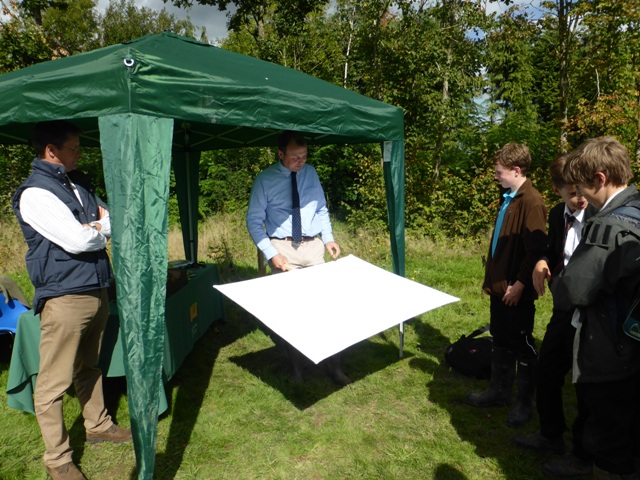
Harvest; probably the most lively response from the students - trees of beautiful fruit just waiting to be picked
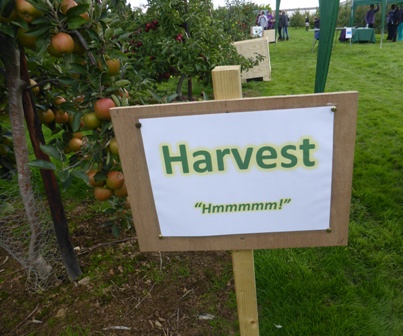
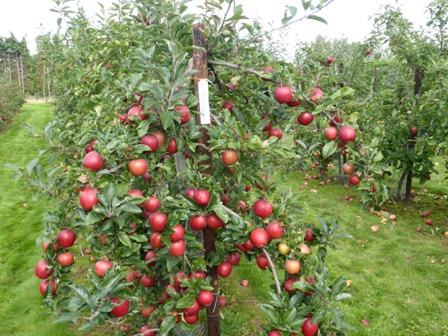
Before picking starts, Stefan Jordan instructed students on the operational requirements for picking; 'cup the fruit gently in the hand' gently 'lift& twist' place the apple 'gently into the picking bucket' - and then, when full, place the picking bucket gently into the bin (avoiding resting the bucket on the edge of the bin) before carefully 'unhitching' the cords on each side and gently allowing the fruit trickle out into the bin.
Stefan Jordan addresses students before they try their hand at picking - and - 'all kitted out' and ready for action!
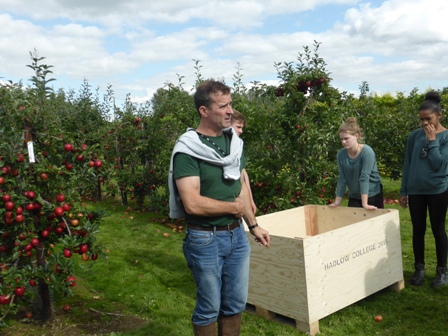
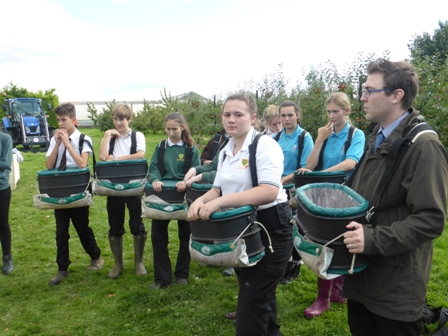
Below: the students get stuck into picking - and - take care emptying the picking bucket into the bins
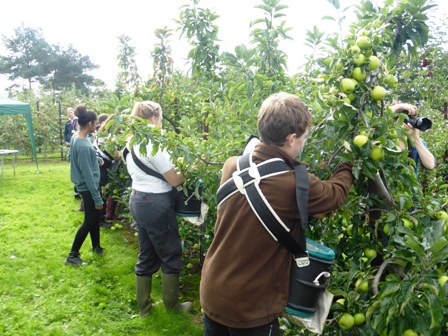
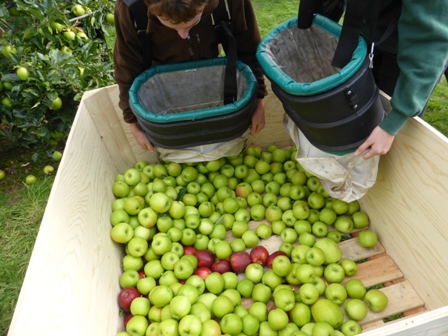
Below: students from Hadlow Rural Community School pose with their bin of apples
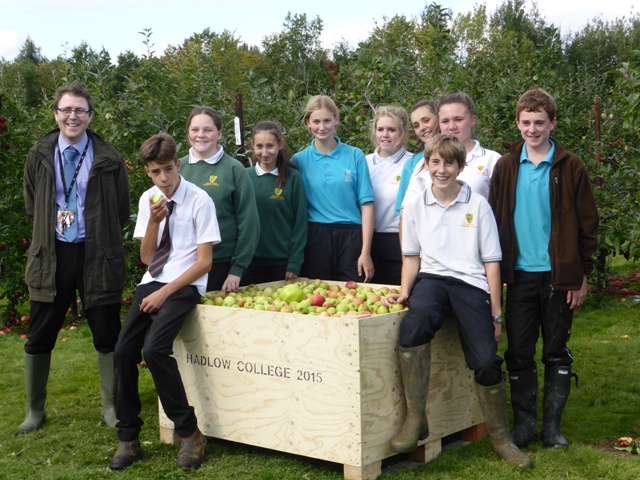
Storage and Applied Science
Clare Hogan - Hadlow BsSc student explained the mechanism of atmosphere controlled apple storage to students and Rosalind Fisher - Hadlow BSc student cover Applied Science.
Clare Hogan - "The Principles of Fruit Storage and how to keep foods fresh 7
Clare outlined the reasons for storing apples - 'Longer supply to the market throughout the year - typically 9 months+ with CA storage conditions' - 'Getting the best price' - and meeting Customer expectations' - Clare informed he students of 'types of storage systems' - which may 'Cooling' - 'Controlled Atmosphere' - 'Dynamic Controlled Atmosphere' (DCA) - 'DX and Secondary refrigeration systems. Clare also covered Store Safety - 'Effects of low oxygen - Effects of High C02 - 'Staying safe!
Rosalind Fisher - 'The devil is in the detail' - pennies make pounds!
In monitoring, measuring and understanding even the smallest performance function of a plant we seek to improve the cost of production in greater output or less inputs. Rosalind demonstrated a SPAD Chlorophyll Meter which instantly measures chlorophyll content or " greenness of plants" - this tool helps manage the risk of yield-limiting deficiencies or costly over fertilising.
Business
Lucy Wright - Hadlow Careers Team - addressed the students on the potential careers available to students pursuing a life in horticulture; many in the past have opted for 'Amenity Horticulture' and Hadlow College has a high success rate in producing students who go onto careers in Amenity, however the potential in the world of edible horticulture is huge; fruit production is a very rewarding career - as a grower, agronomist, technical manager, et al......'so many opportunities'......
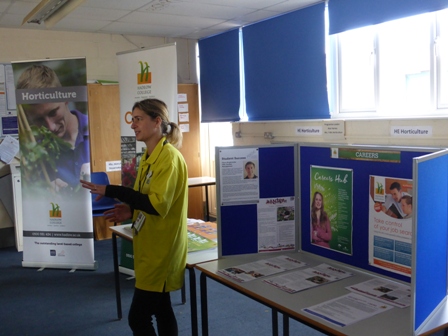
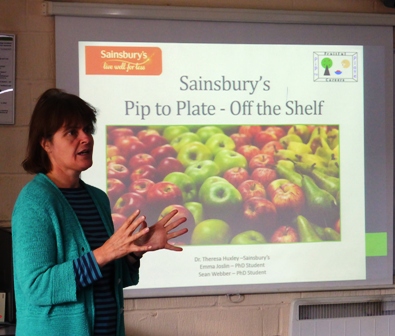
Off the shelf
Dr.Theresa Huxley - Senior Technical Manager for Sainsburys and a good friend of the fruit industry told students Sainsburys sells 'one in three' of British Apples sold in the UK and has sold more British grown apples than any other retailer for the last five years running! Theresa said - "last year we sold over 200 million apples and pears" Sainsburys customers bought over 42,000 tonnes, equal to 5.8 million pieces of fruit......Sainsburys offers 32 varieties of British grown apples & pears throughout the season - the largest selling variety was Gala with 12,300 tonnes.
Below: Theresa Huxley addressing students from Hadlow Rural Community School
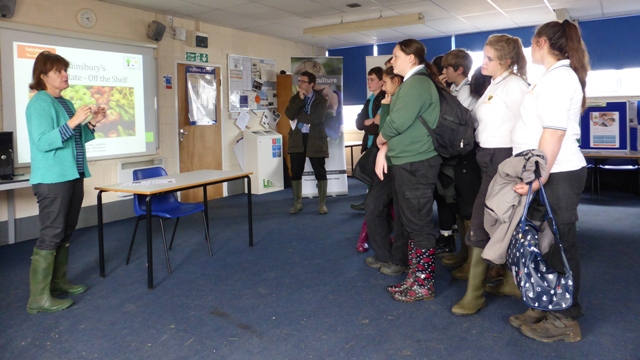
Sean Webber - Sainsburys demonstrated a study he is doing on the benefits of Alleyway cover crops - and - Emma Joslin told students about the benefits of a study she is doing into Hedgerows in orchards
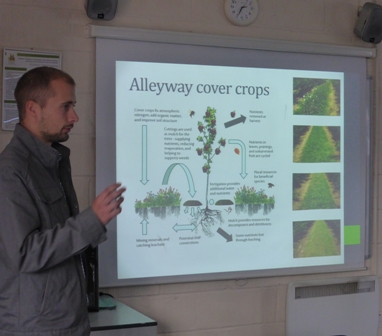
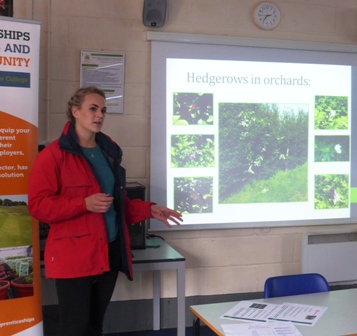
Theresa covered many elements of health benefits from eating fresh fruit and career opportunities; too many for me to cover fully, however the Sainsburys Placement Scheme offers two 6 month placements split between Sainsburys and a leading fresh produce supplier.
Theresa said; "the minimum criteria for placements are identical to the criteria for our graduate schemes"
"We recognise you may not have graduated at this point, therefore we ask that you are 'on track' for 2:1 degree or have relevant equivalent experience"
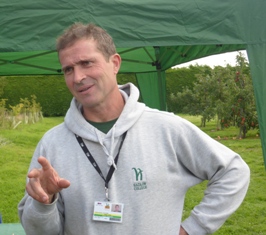 Before I wind up this week's Journal, it is important to recognise the individuals who have contributed to the success of Pip to Plate - and one individual was instrumental in getting Pip to Plate off the ground - in fact he named it Pip to Plate - that person is Stefan Jordan. Stefan was part of the group discussing the idea of an event designed to enthuse young people to take seriously the career opportunities available in 'food based horticulture' - after much discussion Stefan quite simply said - "lets do it" and Pip to Plate was born!
Before I wind up this week's Journal, it is important to recognise the individuals who have contributed to the success of Pip to Plate - and one individual was instrumental in getting Pip to Plate off the ground - in fact he named it Pip to Plate - that person is Stefan Jordan. Stefan was part of the group discussing the idea of an event designed to enthuse young people to take seriously the career opportunities available in 'food based horticulture' - after much discussion Stefan quite simply said - "lets do it" and Pip to Plate was born!
Well it is nearly 9.30pm on Saturday (26th) evening and although distracted by England v Wales at Twickenham in the Rugby World Cup. I have finally finished this week's Journal..........the score by the way is England 22 - Wales 18..........it is very balanced and is anybody's guess who will win!
Take care
The English Apple Man